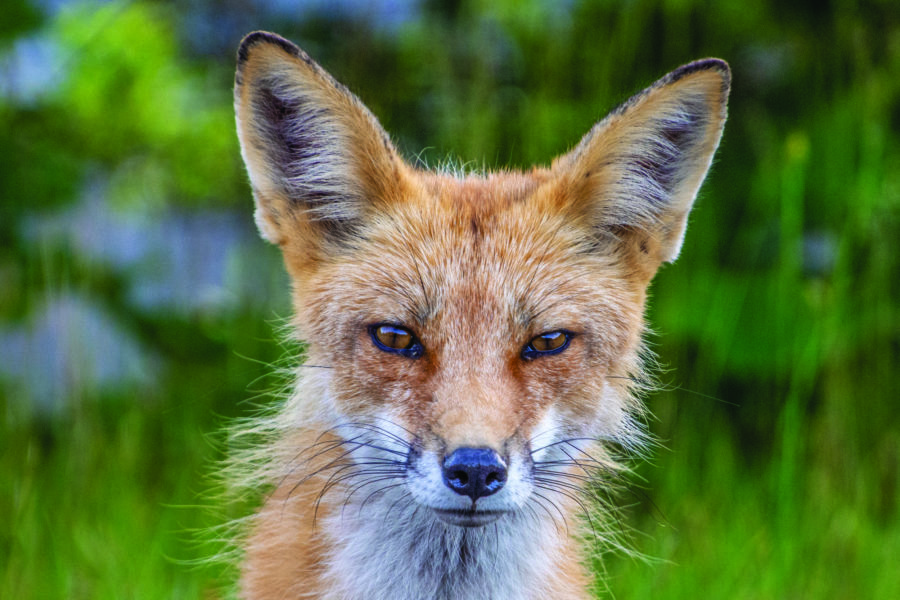PROVINCETOWN — In winter, it’s not uncommon to see a red fox trotting down Commercial Street at dusk. Foxes here have grown used to living near humans, enticed by our garbage and sheltered by our structures.
“Foxes are actually encouraged by suburban development,” said Mark Adams, an artist and ecologist who recently retired as a cartographer with the Cape Cod National Seashore.

In January and February, foxes are seen more than at other times of the year because, said Seashore Supt. Brian Carlstrom, they are currently “out and about looking for mates.”
Those that are successful will build dens to make ready for their cubs. Their gestation period is short, just seven to eight weeks, according to the Mass Audubon website. In March and April, pups will be born. Foxes typically produce three to six pups that are blind and helpless at birth. The pups, also called kits, remain in the den for several weeks and are weaned at about 12 weeks.
As much as the pups “tug at your heartstrings,” Carlstrom said, “they’re wild animals, and they shouldn’t be habituated to humans.” In fact, the Park Service at times uses noise to prevent habituation, Adams said.
Ironically, the large number of second homes in Provincetown means foxes have plenty of places to live, said Mark Faherty, the science coordinator at Mass Audubon’s Wellfleet Bay Wildlife Sanctuary.
“Absentee landlords provide a perfect landscape for foxes,” said Faherty. They will burrow 10 to 15 feet into the sandy soil, often appropriating spaces under sheds and decks to build dens they’ll return to yearly.
Foxes mate for life, and fox pairs typically maintain about a two-square-mile territory. But after mating season, Faherty said, he doesn’t expect to see foxes together. Both foxes and coyotes are solitary hunters, but only coyotes gather in groups at night.
Though the Park Service does not track fox population numbers, Adams, quickly dividing Provincetown’s land mass into square-mile parcels, estimated anywhere from dozens to 100 foxes could live in town.
Although foxes in captivity can live for up to 10 years, foxes in suburban areas, where they’re preyed on by coyotes and hawks, live only about three years, said Adams. But that short life span doesn’t mean humans should intervene.
“Feeding foxes can lead to a higher population density than the landscape can support,” said Stephanie Ellis, executive director at Wild Care in Eastham. That, in turn, can make them susceptible to mange or other density-dependent diseases.
The Provincetown Banner reported on a mange epidemic that affected foxes in 2016. At that time, a member of the town’s animal welfare committee said she gave residents instructions on how to feed medicated meatballs to diseased foxes.
Carlstrom said no one should feed foxes. The Park Service can issue fines to people who feed wild animals, though Carlstrom added they have not had to do that recently.
Both Carlstrom and Faherty view mange as a “natural regulator.” The fox population peaked before the mange outbreak and then declined again. Now, though, Carlstrom thinks the sight of healthy-looking foxes on Commercial Street is evidence of a return, if not stabilization, of the fox population.
Ellis said her organization, which covers all of Cape Cod, received over 10,000 reports of distressed animals last year involving 151 species. During the winter, most calls are about sea birds after storms, she said. But as spring brings mammalian mating season, the hotline receives more calls about animals people think might be orphaned.
A lone fox pup is not necessarily in trouble. Ellis warned against “ ‘over-rescue’ — a nicer word than ‘kidnap,’ ” she said.
If an animal is injured, Carlstrom said, it’s still best not to intervene. “Call the experts,” Carlstrom said, at the Park or at Wild Care. Foxes, he added, are a rabies vector species.
Ellis acknowledged that rehabilitated animals probably face a tougher future in the wild than uninjured ones.
“But even the animals that don’t survive provide us with important information,” Ellis said. Faherty agreed that data from centers like Wild Care could serve as “first sentinels” to monitor diseases or injury patterns.
Rehabilitation may serve an important warning role and “be good for the soul,” as Adams put it, but he also pointed out that human involvement has its limits.
“Nature has a balance sheet of survival,” he said. “Nature will decide.”



